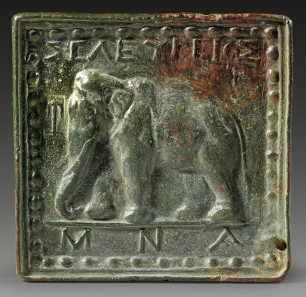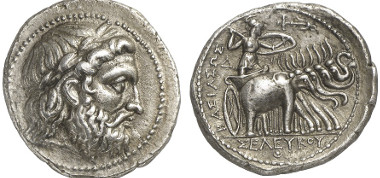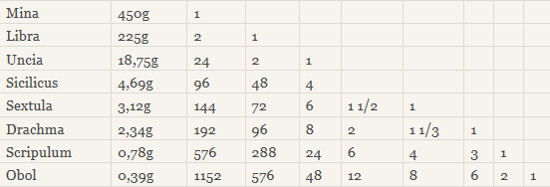A Weight from the Empire of the Seleucids
Nomos – that was how the ancient Greeks referred to the coin. But Nomos stands for much more. Nomos was any law laid down, any custom, any agreement and, of course, any measure and weight a given city determined for itself. In the hymns of Orpheus, Nomos is associated with Nemesis (revenge, retributive justice), Dike (moral justice) and Dikaiosyne (righteousness of the community and the government), hence with all the concepts that were the core of any regulated human co-existence. Without Nomoi, without arrangements of the citizens of a town, it was impossible to conclude a contract, whether for the sale of a house, for a marriage, or for a small transaction when an object changed hands.
Many ancient weights have come down to us that tell of the strong link between weight and coin as an expression of a governmental rule. This is why the symbols of power often appear on both Nomoi, the coin and the weight.
Market weight from Seleucia. 3rd cent. B. C. From auction sale Gorny & Mosch 218 (2013), 30. Estimate: 5,000 euros. End result: 23,600 euros.
In the present case, elephant and anchor are known to us as iconographic symbols for the rule of the Seleucid dynasty. They are shown, for example, on a tetrachdrachm of Seleucus I from Seleucia at the Tigris. Athena rides in an elephant quadriga and an anchor is shown above in the field.
Seleucus I Nicator, 312-281. Tetradrachm, after 296/5, Seleucia at the Tigris. From auction sale Gorny & Mosch 211 (2013), 433. Estimate: 1,500 euros. End result: 4,600 euros.
On a market weight, offered for sale on 18th December 2013, in the sale of ancient art of Gorny & Mosch, a single elephant is depicted, standing to the left, with a countermark in the shape of an anchor in front. The inscription states Seleucia as the origin of this weight but which one of the many cities bearing this name is meant can’t be said for sure on the basis on the inscription alone. What is clearly specified, on the other hand, is the weight of that piece of bronze: a mna, as the Greeks wrote. We would call it mine or mina with that term being borrowed from the Semitic language.
Shraga Quedar has made a list of the Phoenician standard on the basis of the weights known to him as early as 1983. Our weight with its 457 grams fits magnificently into this system.
The Phoenician standard, c. 3rd cent. B. C. to 3rd. Cent. A. D.; as in David Hendin, Ancient Scale Weights and pre-coinage currency of the Near East, Nyack (2007), p. 93.
As a matter of fact, it was officially checked and approved, to which the anchor countermark is likely to refer. Its new owner paid the impressive sum of 23,600 euros for this testimony to ancient economic history. Thus, he is on a par with the Getty Museum that houses an identical piece, bearing the inventory number 96.AC.142, although that one is significantly heavier, 535 grams to be exact.
Further information on auction sale Gorny & Mosch 218, Ancient Art, is available on the internet.








